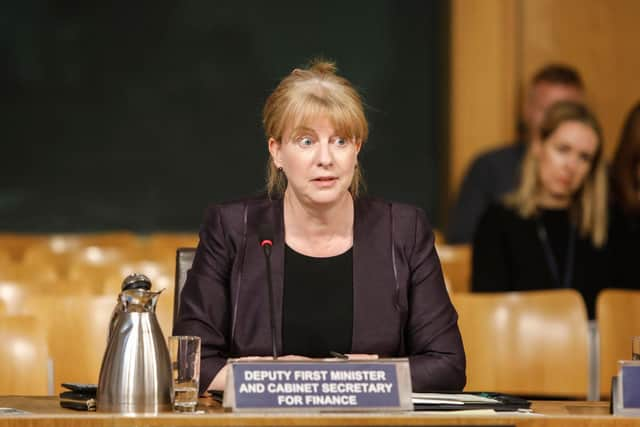The gap between Scottish Government spending and income could reach a staggering £4 billion by 2027-28
It is not often that I feel nostalgic for the days when Derek Mackay was in charge of Scotland’s finances. I shadowed the former Finance Secretary and, whilst we had many political differences, I respected him as someone who at least understood the role, and the need for the Scottish Government to balance its books at the end of every year.
He was followed in office by Kate Forbes, a capable minister with a background in accountancy who appeared to be in command of her brief. Mackay has long since left politics and is now rebuilding his reputation and his career in consultancy. Forbes has been relegated to the backbenches where she is the “Queen over the water” for the many SNP MSPs and party members who watch with increasing dismay as Humza Yousaf slowly self-destructs as First Minister.
At least both Mackay and Forbes had a grasp of what they were trying to do. Now we have Shona Robison as both Deputy First Minister and Finance Secretary. Robison has no background, professionally or politically, in business and finance but she shares something with the First Minister in that they are both failed former Health Secretaries. Indeed her only qualification for her latest job appears to be her loyalty to Yousaf and her role in delivering him the SNP leadership, rather than an ability to perform.
This was startlingly obvious last week in the Scottish Parliament when she delivered the Scottish Government’s Medium-Term Financial Strategy, setting out expected revenues and spending over the next four years. Asked a succession of straightforward questions, she had all the spontaneity of a brick wall. She resorted to reading lengthy pre-prepared statements from her crib sheet, failing to respond to the legitimate points being raised by opposition MSPs. This was a minister with a white-knuckled grasp of her advisers’ notes but little grasp of her brief.
Perhaps it is not surprising that the minister was unable to deal with any detailed scrutiny of the statement she was making to parliament. The reality is the medium-term financial strategy contains some grim figures for anyone concerned about the state of Scotland’s economy and finances.
That is just on the central spending and funding outlook. On what is known as the “downside scenario”, those figures rise to £1.6 billion in the next financial years and a staggering £4 billion in 2027-28. To say that this is extremely serious for a government that has to balance its books every year would be a major understatement.


So why are we in this position? Essentially because the growth in spending is outstripping the rise in revenues. In particular, the social security budget is growing exponentially, with the Scottish Fiscal Commission forecasting an increase in spending from around £5 billion in the current financial year to £7 billion in 2026-27.
The Scottish Government’s budget is essentially made up of two key components – the Westminster block grant, and the income from devolved taxation, principally income tax and non-domestic rates. Whilst the block grant is now at historic record levels, room for substantial growth over the coming years is expected to be limited. We have in previous years seen in-year increases in spending from the UK Government generating Barnett consequentials for Scotland, and it is possible that this pattern could be repeated, easing some of the pressure on the Finance Secretary. But only some of it.
Any such financial benefit coming from Westminster is highly unlikely to plug the £1 billion-plus gap we are going to see next year. That means that either taxes are going to have to rise still further, or spending will have to be cut. Either of these options is politically unpalatable, although it is noteworthy that already the First Minister has been talking about the need to increase taxes on middle earners even further.
Income tax divergence between Scotland and the rest of the UK already means that those earning £50,000 are paying approximately £1,500 a year more than their neighbours south of the Border. We increasingly hear figures in business, including the finance sector, telling us these tax differentials are actively discouraging talented individuals either from staying in Scotland to pursue their careers or moving here from elsewhere in the UK.
There is of course a third option, which would seem to have an obvious attraction for the government, and that is to grow the Scottish economy, generating more tax revenues through wage growth. We know that since 2014 the Scottish economy has grown on average at half of the rate of the UK as a whole.
Last week I asked the Finance Secretary how much additional tax would have accrued to the Scottish budget had growth at least matched that of the UK over that period. She was unable – or unwilling – to give me an answer. It would amount to billions of pounds which would have been available for additional spending in Scotland, or to reduce the tax burden.
Bereft of ideas, Robison was left plaintively asking opposition parties for their ideas on how to fill the funding gap that she and her party have created. A graphic example of being in office but not in power. It is the political equivalent of the arsonist pleading with the forlorn dressing-gown clad householders standing on the pavement watching the flames rip through their home to don firefighting equipment and put out the fire.
The problem we are in today is one entirely of the Scottish Government’s own making. Loyalty to Yousaf might get you a job – but it doesn’t mean you can do it.
Murdo Fraser is a Scottish Conservative MSP for Mid-Scotland and Fife
